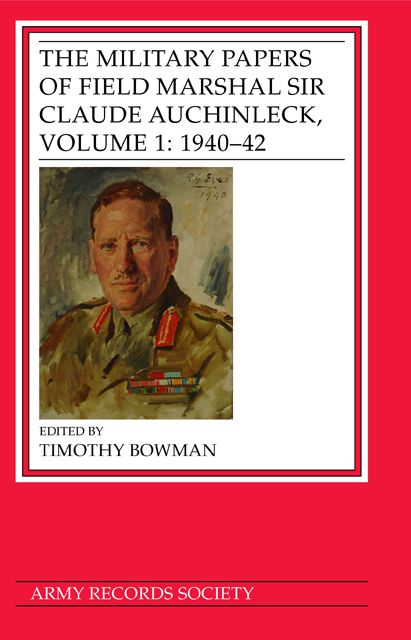Book contents
3 - Commander in Chief, India, 1940–41
Published online by Cambridge University Press: 02 June 2023
Summary
Auchinleck as C in C India was anxious to develop a programme which would modernise and expand the Indian Army. On his return to India, he was impressed by what had been achieved in his absence and believed that within seven months armoured units would be sufficiently developed to take the field [40]. The development of armoured forces was something Auchinleck was to return to [50, 57]. Auchinleck's desire to develop the Indian Army's AA capabilities, when the number of guns was limited is also evident [41]. Most surprising, in terms of modernisation, was Auchinleck's desire to develop a parachute brigade within the Indian Army. A lesser general might have concluded that the lack of aircraft, gliders or parachutes made this a pointless task [65, 66].
Auchinleck was keen to expand the recruiting base of the Indian Army far beyond that of the traditional martial races by resurrecting old regiments and forming new ones. In doing this he promoted the development of modern recruiting campaigns [43, 67]. He believed that expansion should go ahead, even if the British contingents normally supplied to each Indian Division were not forthcoming [68]. With regard to the martial races, Auchinleck also outlined the problems seen in the rapid expansion of the number of Gurkha battalions within the Indian Army, which led to serious shortages of officers and NCOs [41].
Auchinleck maintained his belief in the need to Indianise the officer corps of the Indian Army, but at the same time he was keen to obtain as many trained officers as possible from the UK and from British families living in India. Perhaps with memories of his own early career he did not want cadets coming from Britain to be put to the expense of equipping themselves with civilian clothes and he was concerned at the pay disparity between British and Indian officers serving in the Indian Army [40, 43]. He was particularly concerned at the lack of middle-ranking officers in the expanded Indian Army and resisted attempts to obtain such regular officers for irregular units being formed in Singapore [43]. Auchinleck also believed that a wartime spirit should be adopted by officers in India, insisting that all officers should wear uniform, and he was also keen to centralise all headquarters staff in Delhi [40, 59].
- Type
- Chapter
- Information
- Publisher: Boydell & BrewerPrint publication year: 2021



